With its red flower buds, white flowers and red berries, the Skimmia is a beautiful sight in the garden in both summer and winter.

There are only a few plants that also have ornamental value in winter. Skimmia japonica definitely part of it. The striking red flower buds, red berries and dark green foliage remain throughout winter. In spring, the many white flowers exude a pleasant scent.
contents
- Skimmie: flower, origin and properties
- The most beautiful Skimmia varieties and species
- Plant Skimmia: location, timing and procedure
-
Caring for the Skimmia: cut, water and fertilize
- Water and fertilize
- Cut Skimmia
- Yellow leaves on the skimmie: what to do?
- breed Skimmia
- Hibernation: Is the Skimmia hardy?
- Is the Skimmia poisonous?
Skimmie: flower, origin and properties
Skimmias belong to the rue family (Rutaceae), which also includes citrus plants such as oranges or lemons. The most well-known genus is Skimmia japonica
(Synonym: Skimmia fragrans), also known as Japanese, dwarf, or flower skimmia. Skimmias are native to eastern Asia and grow in shady, cool, damp locations in the forests of China, Korea, and Japan. The plants have dark green, laurel-like leaves and reach a height of approx. 1.5m They are one of the few evergreen ornamental trees and have a high ornamental value even in winter. In autumn, the shrubs form flower buds in panicles, which are usually bright red in color and remain in place throughout the winter. Between May and April, the small individual flowers open and have a pleasant scent. The flower color is white to pink.Most skimmias are dioecious, meaning there are plants that only have male flowers and plants that only have female flowers. Both types produce the typical flower buds, but only the female plants develop the approx. 1 cm large berries, which slowly turn red in summer. In order for these berries to develop, a male plant is also required nearby to produce the required pollen. Whether you are a male or female Skimmia-plant, you can tell by looking at the individual flowers more closely. Female flowers have a central pistil in the center of the flower, while male flowers usually have four stamens on a short stalk, the filament. If you are planting skimmias in the garden and want to harvest berries from them, you will need at least one male plant. This is the only way that berries can develop on the female Skimmia.

Tip: The varieties sold commercially are either male or female. male Skimmia Varieties are sold as flower skimmias and female varieties as fruit skimmias.
The most beautiful Skimmia varieties and species
- Skimmia japonica ‘Rubella’: This variety belongs to the flower skimmia, i.e. to the purely male varieties. The flower buds are dark red and the flowers are light pink.
- Skimmia japonica 'Temptation': It is a female variety or fruit skimmia. When the white flowers are fertilized, they produce bright red small berries from August to September.
- Skimmia japonica ‘Veitchii’: The variety is also a fruit skimmie with red fruits. The flowers are white to pink in color.
- Skimmia reevesiana: These Skimmia-Art develops male and female flowers. A plant alone is therefore able to produce fruit. The flowers of Skimmia reevesiana are light pink and the berries are red.
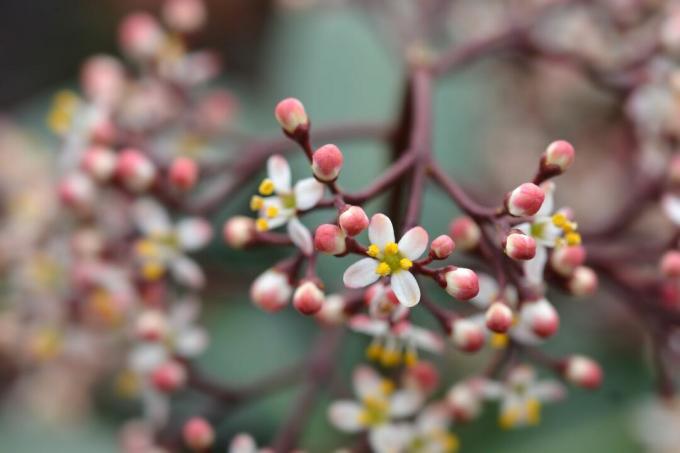
Plant Skimmia: location, timing and procedure
Skimmias thrive best in a sheltered, shady spot with little direct sunlight. You can plant skimmias as a single shrub or in a group. When planting as a single shrub, a distance of 1.5 m should be maintained. In a group planting, no more than three plants per square meter should be planted. You can plant skimmias all year round in frost-free weather, but autumn is best to ensure good growth. The shrubs love humus-rich, nutrient-rich and slightly acidic soil with a pH of 4.8 - 5.2. Good neighboring plants include rhododendrons or heather plants. If the soil is too alkaline, adding an acidic soil is recommended. Our plants Organic acidic soil With a pH of 4.6 to 5.4, it is an ideal way to reduce the pH in the desired place.
The soil should be kept constantly moist. To do this, dig a hole for each plant that is about twice as big and deep as the root ball and fill it halfway with the acidic soil. Now you should water the soil extensively and use a shovel to mix the potting soil and the soil of the hole well. This allows the peat contained to absorb the water and swell. Then the skimmia can be placed in the middle of the hole and the planting hole filled with the acidic soil. Press the soil down firmly and water the plant abundantly again after planting. In the first few weeks after planting, the soil should always be kept moist.
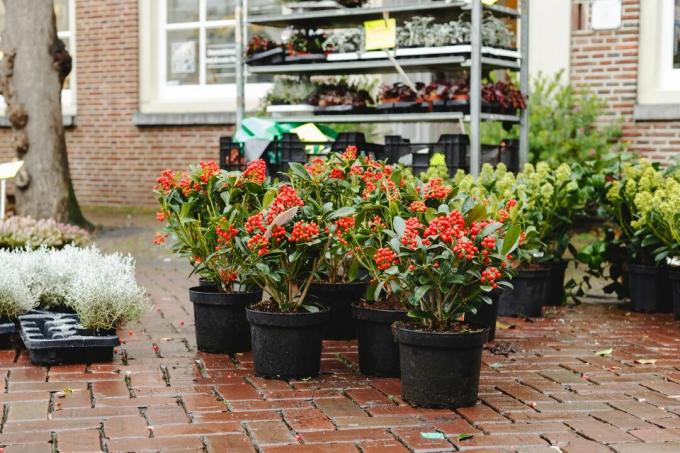
Summary: Plant skimmias
- Plant in acidic soil, adding acidic soil if necessary
- Dig out the planting hole and if necessary fill it halfway with acidic soil
- Mix everything with plenty of water ("soak")
- Put the plant in the planting hole and fill it with acidic soil
- Don't press the soil too hard, water generously again
Plant Skimmie in the tub:
- Fill a sufficiently large pot with slightly acidic plant substrate
- In summer it should be watered regularly
- In winter, the bucket must be protected from frost
- Skimmias are not suitable as houseplants: they need a cool and humid environment, as well as a cold hibernation
Caring for the Skimmia: cut, water and fertilize
Skimmias also tolerate colder temperatures. There is also not much to consider in terms of care.
Water and fertilize
Young plants should be watered at least every two weeks. Mature plants only need to be watered during longer periods of drought. A dose of slow-release fertilizer per year in spring is quite sufficient for good growth. Acidic fertilizers lower the pH of alkaline soils.
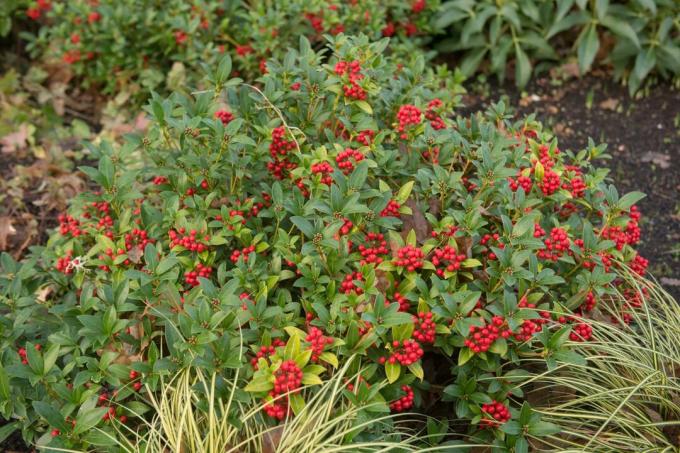
Cut Skimmia
Skimmia require hardly any pruning measures. Faded inflorescences can be removed. Female inflorescences should be left in place to allow the red berries to develop. Unfavorably growing shoots can be shortened without any problems.
Yellow leaves on the skimmie: what to do?
As a rule, skimmias grow without major problems. If the leaves are yellow, something is wrong.
- Too much sun/drought: Skimmia can form yellow spots on the leaves if the sun is too strong and the air is too dry. It is important to provide adequate shading and moist soil at the root of the skimmia.
- Unfavorable ground: Another cause could be a too alkaline or calcareous soil, because from such the skimmia finds it difficult to absorb nutrients. Acidic soil or fertilizers that are acidic can lower the pH of the soil around the plants.
- nutrient deficiency: If there is a nutrient deficiency, this is often due to the nutrient elements iron, magnesium or nitrogen. In the case of a nitrogen deficiency, the older leaves appear light green to yellow first, depending on the severity of the deficiency. The leaves are evenly colored. If there is a magnesium deficiency, the older leaves are also affected first, but the leaf veins remain green for a long time. Iron deficiency, on the other hand, first appears on the younger leaves, but the leaf veins also remain green. If the soil of the skimmie is too alkaline, a combination of magnesium and potassium deficiencies can also occur. An acidic fertilizer can help lower the pH. Our Plantura organic hydrangea fertilizer is also suitable for skimmia and other bog plants as it lowers the pH and contains iron to compensate for soil deficiencies.
Summary: Fix Yellow Leaves on Skimmia
- Choose a shady place
- Plant in acidic substrate
- Use special fertilizer for ericaceous plants with an acidic effect
- Always water with acidic rainwater, avoid tap water
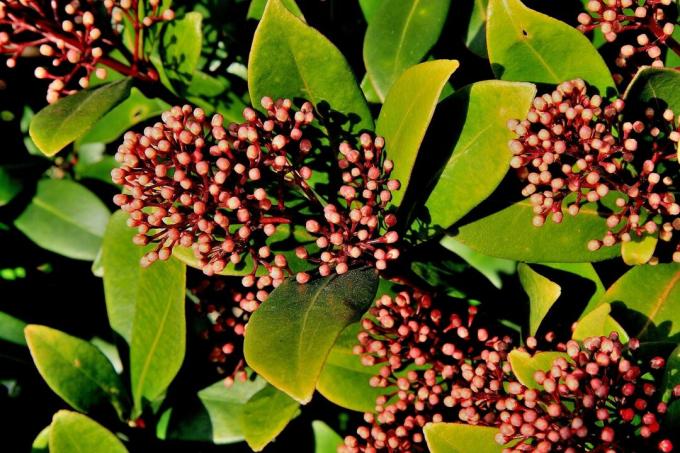
breed Skimmia
Skimmia can be propagated quite easily. The easiest way to do this is with cuttings. The new plants retain the sex of the mother plant. For this, between June and September, cut approx. 15 - 20 cm long shoots and remove the lower 3 - 4 leaves. Put the cuttings in a pot with acidic soil mixed with a third of sand and water the cuttings vigorously. Make sure that the substrate is permanently moist during the growth phase. The Skimmia should be overwintered in a frost-free place.
Hibernation: Is the Skimmia hardy?
Most Skimmia varieties are hardy and tolerate temperatures down to – 20 °C without any problems. Adult specimens do not need winter protection in most regions, but freshly planted and younger plants should be protected in winter. It is best to cover these plants with a layer of leaves, fir branches or straw.
Plants in tubs should be overwintered in a cool but frost-free place. The plants should at least get some light.
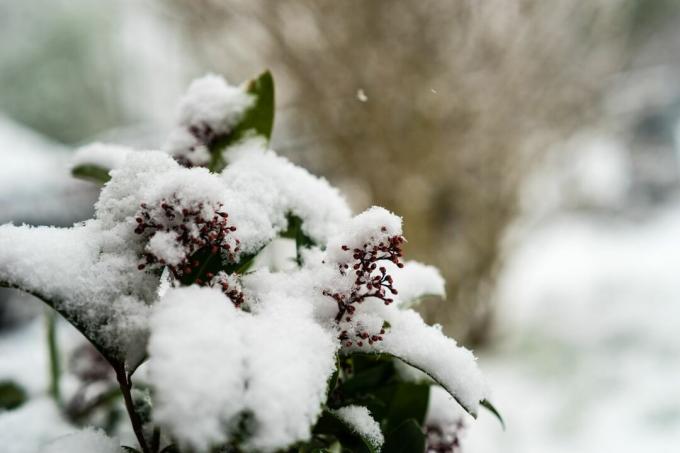
Is the Skimmia poisonous?
All parts of Skimmia are considered slightly poisonous. They contain alkaloids, which, in small amounts, mainly cause nausea. For pets, the plants are usually not particularly interesting. However, the red berries are popular fodder for birds in winter.
Skimmias aren't the only beautiful ornamental shrubs that do well in acidic environments. Rhododendrons also prefer acidic soils and show their lush flowers there during the summer. As Planting and caring for rhododendrons, you will learn in this article.
